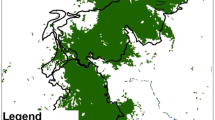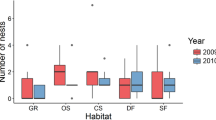Summary
Polyrhachis laboriosa andP. militaris are two tree-inhabiting ant species, belonging to the subgenusMyrma common in Cameroon forest. WhileP. laboriosa live on pioneer trees on the edge of forest tracks,P. militaris inhabit dense equatorial forest. Foundation of societies is independent in these two species. Founding queens ofP. laboriosa made small cells under leaves, while foundresses ofP. militaris made cells in soil, hollowed dead branches, or old termitaria. The queens left their cells daily to forage. They collected water, sugared juices, and prey. They were also observed “grazing” the surface of leaves.P. laboriosa queens also collected vegetal matter which was then used to build their founding cells under leaves. This behavior was observed in both the field and the laboratory. This article is the first description of semi-claustral foundation in a formicine ant. It may be related to the fact that these ants are protected from predators by mandrels (hooks) on the thorax and the petiole. Bright yellow coloration of the gaster may also serve as an aposematic warning signal for potential predators. Prey capture was studied in the two species by offering both small (isolated or in group) and large prey to the foundresses. Hunting behavior ofPolyrhachis queens was similar to that of workers, and was identical in the two species.
Similar content being viewed by others
References
Bolton, B., 1973. The ant genusPolyrhachis F. Smith in the Ethiopian region (Hymenoptera: Formicidae).Bull. Brit. Mus. (Nat. Hist.) Entomol. 28:285–369.
Dejean, A., 1980. Le comportement de prédation chezSerrastruma serrula Santschi (Formicidae, Myrmicinae). 1. Analyse de la distance de détection par les ouvrières pourvoyeuses, étude des phases comportementales.Ann. Sc. Nat. Zool. 2:131–143.
Dejean, A., 1988. Failure as an efficient stimulus of a “reserve behaviour” which allows the capture of alternative prey bySerrastruma serrula workers (Formicidae, Myrmicinae).Sociobiology 14:325–340.
Dorow, W. H. O., U. Maschwitz and S. Rapp, 1990. The natural history ofPolyrhachis (Myrmhopia) muelleri Forel 1893 (Formicidae Formicinae), a weaver ant with mimetic larvae and an unusual nesting behaviour.Trop. Zool. 3:181–190.
Dumpert, K., 1981.The social biology of ants. Pitman Publ, 297 pp.
Guilford, T., 1990. Evolutionary pathways to aposematism.Acta Oecol. 11:835–841.
Hölldobler, B. and E. O. Wilson, 1977. The number of queens: an important trait in ant evolution.Naturwissenschaften 64:8–15.
Hölldobler, B. and E. O. Wilson, 1990.The Ants. Springer-Verlag, Berlin, 732 pp.
Lachaud, J. P. and A. Dejean, 1991. Etude critique de la fondation des colonies en claustration totale chez les ponérines du genreBrachyponera.Actes Coll. Insectes Sociaux 7:59–66.
Ledoux, A., 1958. La construction du nid chez quelques fourmis arboricoles de France et d'Afrique tropicale.Proc. 10th Int. Congr. Entomol., Montréal 1954 2:521–528.
Lenoir, A., L. Querard, N. Pondicq and F. Berton, 1988. Reproduction and dispersal in the antCataglyphis cursor.Psyche 95:21–44.
Ofer, J., 1970.Polyrhachis simplex, the weaver ant of Israel.Ins. Soc. 17:49–82.
Wheeler, W. M., 1922. Ants of the Belgian Congo, part 2.Bull. Am. Mus. nat. hist. 45:39–269.
Wilson, E. O., 1971.The Insect Societies, Harvard University Press, Mass., 548 pp.
Yamauchi, K., Y. Ito, K. Kinomura and H. Takamine, 1987. Polycalic colonies of the weaver antPolyrhachis dives.Kontyû 55:410–420.
Yi, C. and T. Jue, 1990. The nesting behaviour of the spined ant,Polyrhachis vicina Roger.Acta Entomol. Sinica 33:193–199 (Chinese, with English summary).
Author information
Authors and Affiliations
Rights and permissions
About this article
Cite this article
Lenoir, A., Dejean, A. Semi-claustral colony foundation in the formicine ants of the genusPolyrhachis (Hymenoptera: Formicidae). Ins. Soc 41, 225–234 (1994). https://doi.org/10.1007/BF01242293
Received:
Revised:
Accepted:
Issue Date:
DOI: https://doi.org/10.1007/BF01242293




